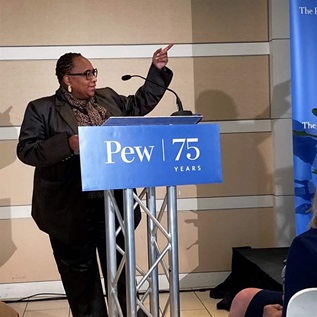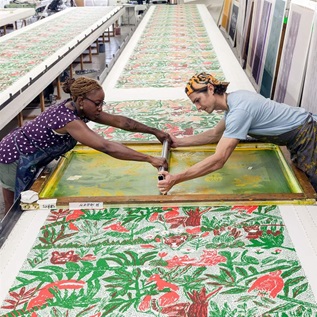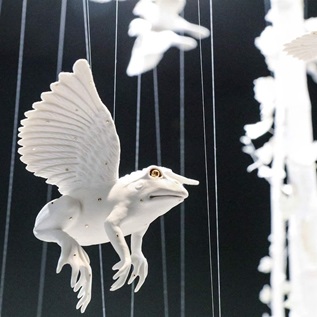Heritage Philadelphia Awards $400K to Regional Historic Sites
Philadelphia, PA-The Heritage Philadelphia Program, funded by The Pew Charitable Trusts and administered by the Independence Visitor Center Corporation, has awarded seven grants totaling $413,491 to historic sites in the Greater Philadelphia region. The funds will go toward planning new exhibits, developing special experiences for visitors and doing research at churches, museums, mills and other historic places in the region.
The Heritage Philadelphia Program, established in 1998, provides grant funding, support and professional development services to museums and historic sites in the Greater Philadelphia region. HPP's mission is to foster a single vision, a united focus and comprehensive services for interpreting and preserving Philadelphia's historic treasures.
Since its inception, the Heritage Philadelphia Program has received international recognition for its creative, holistic and practical approach to the challenges facing the region's house museums and other historic places, and it remains the only program of its kind in the nation. Terry Davis, president and CEO of the American Association for State and Local History notes, “The Heritage Philadelphia Program is leading the way with its creative and practical approach to the public presentation and preservation of historical resources.”
“We are proud to be recognized as the most innovative program in the country that presents history to the public,” said HPP executive director Barbara Silberman. “Greater Philadelphia is home to an unparalleled national treasury of buildings and collections covering a wealth of historical periods and themes. It's our job-- and it makes good cultural and business sense--to ensure that these resources are available to the public through the support and funding provided by our program.”
The awards were judged by a national panel of museum professionals, historians and architects. Assisting panel chair Gretchen Sullivan Sorin, director of New York's Cooperstown Museum Studies program, were: Martha Dyckes, director of interpretive services for the Colorado Historical Society; Pamela Hawkes, AIA, vice president of Ann Beha Associates in Cambridge, Mass.; Mike Jackson, FAIA, state historic preservation officer and chief architect for the Illinois Historic Preservation Agency; Janet Kamien, former vice president of the Franklin Institute and exhibit developer for the National Constitution Center; Susan McLeod, executive director of the Chippewa Valley Museum in Eau Claire, Wisc.; and Sheldon Wolf, former development and marketing director for the New England Aquarium.
In alphabetical order, the awards are as follows:
- American Philosophical Society: $75,000 for the planning of the 2006 exhibit, “Princess and Patriot: Ekaterina Dashkova, Benjamin Franklin and the Age of Enlightenment.” This exhibition is part of a city-wide planning effort for the Tercentenary of Franklin's birth.
- Christ Church Preservation Trust: $75,000 for planning that will assess audiences and collections; develop new stories and exhibit designs; explore collaborations with other historical attractions in the region, and create conceptual marketing strategies for an important gathering place, church and graveyard of the American Revolution.
- College of Physicians of Philadelphia (Mütter Museum): $50,000 to create a Visitor Experience Master Plan that will build on the current exhibitions and redesign the space and other amenities for the 60,000 people who visit annually. The Mütter Museum displays specimens of human anatomy and aberrations of diseases and other medical ailments.
- National Archives and Records Administration, Mid-Atlantic Region: $48,845 for a planning project to produce a strategic framework for exhibitions and public programs. The National Archives is the repository of the holdings of federal court decisions made in Philadelphia, all records for the port of Philadelphia, and patents for popular inventions like colored M&M's.
- National Museum of American Jewish History: $64,646 for the development of a comprehensive web-based catalogue of objects, documents and artifacts related to the history of American Jewish freedom.
- The Mill at Anselma Preservation and Educational Trust, Inc.: $50,000 to develop themes and stories for an 18th-century grist mill that was in operation until the 1930s. The mill incorporates many generations of mill technology and has preserved a waterwheel and other original mill-production machinery.
- University of Pennsylvania Museum of Archeology and Anthropology: $50,000 to study the architecture and building methods for a complex of buildings designed, in part, by noted Philadelphia architect Wilson Eyre. The study will provide information about buildings that will be available to the public for the first time.
The Pew Charitable Trusts serves the public interest by providing information, policy solutions and support for civic life. Based in Philadelphia, with an office in Washington, D.C., the Trusts make investments to provide organizations and citizens with fact-based research and practical solutions on challenging issues. In 2003, with approximately $4.1 billion in dedicated assets, the Trusts committed more than $143 million to 151 nonprofit organizations.











